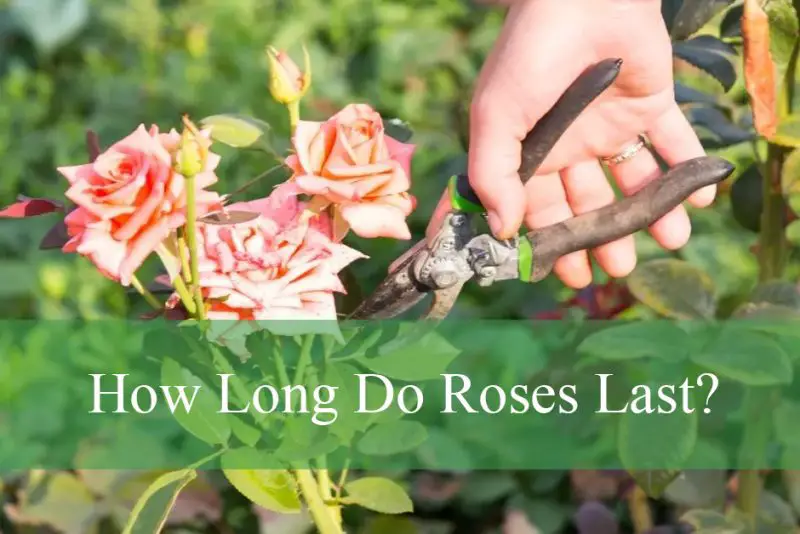Roses are timeless symbols of beauty, love, and elegance. Whether gifted in a romantic bouquet or blooming proudly in a garden, they bring a special charm that few flowers can match. Yet as stunning as they are, roses don’t last forever—and understanding their lifespan is essential if you want to enjoy them longer.
Many people are surprised by how quickly fresh roses can fade without the right care. Factors such as temperature, hydration, light, and variety all play a part in how long roses stay fresh and vibrant. Without proper handling, even the most beautiful roses can wilt within days.
In this guide, we’ll explore exactly how long roses last in different settings—from vases and gardens to preserved and dried forms. You’ll also learn valuable tips to extend their beauty, helping your roses stay radiant far beyond their typical shelf life.
Understanding the Lifespan of Roses

The longevity of a rose depends on a variety of factors including its environment, how it was harvested, and how it’s cared for after purchase. Freshly cut roses can last anywhere from 5 to 12 days, but this can change based on several conditions. For example, roses kept in clean water and away from direct sunlight usually outlive those neglected or improperly maintained.
Roses left uncut on the bush can thrive for several weeks, especially if the plant is healthy and growing in ideal conditions. In contrast, roses used in floral arrangements without water or proper care may begin to wilt within a day or two. The lifespan of preserved roses or dried roses, meanwhile, can stretch into months or even years depending on the preservation technique used.
Different rose varieties also have different lifespans. Hybrid tea roses may last longer than miniature roses or wild varieties. The time of year and temperature also play significant roles, as roses kept in cooler environments tend to last longer than those exposed to heat.
How Long Do Roses Last in a Vase?
When placed in a vase, cut roses generally last between 7 to 10 days. However, this duration can be maximized with attentive care. Using clean water, trimming the stems at an angle, and keeping them away from ripening fruit and direct sunlight are essential steps.
Vase life also depends on how recently the roses were cut before being placed in water. The fresher the cut, the better the roses will absorb water and nutrients. Florists often re-cut stems before arranging them, which helps maintain hydration and prevent premature wilting.
Bacterial growth in vase water is one of the leading causes of short rose lifespan. Changing the water every two days, adding flower food, and removing any foliage submerged in the water can significantly enhance how long the roses remain fresh and visually appealing.
How Long Do Roses Last in the Garden?
In garden settings, roses enjoy a longer lifespan. Depending on the climate and rose variety, blooms can last anywhere from 2 to 3 weeks on the bush. This period may be shorter during intense heat or longer during cool spring and fall seasons.
Garden roses benefit from a steady supply of nutrients and water through the soil, and they’re supported by the root system of the plant. Because of this, they don’t experience the same shock as cut flowers. Deadheading, or the removal of spent blooms, encourages the plant to produce new flowers and helps extend the overall blooming period.
The soil quality, sunlight exposure, and watering schedule all affect how long roses last outdoors. Roses planted in well-drained soil with regular feeding and pruning tend to produce healthier and longer-lasting blooms compared to those left to grow untamed.
How Long Do Roses Last Without Water?
Roses without water begin to wilt quite rapidly. In warm environments, you may notice petals drooping within just a few hours. Depending on the ambient temperature and humidity levels, a rose without water might only last 6 to 24 hours before becoming visibly limp and lifeless.
Transportation or short-term display without water is sometimes inevitable, especially for gift bouquets or events. In these cases, florists often wrap the stems in damp paper towels and plastic to slow dehydration. However, once the water supply is completely removed, the roses begin to suffer.
Rehydration can sometimes revive a drooping rose if done quickly. Re-cutting the stems under water and placing them in a fresh vase with warm water can help restore their appearance, especially if they have only been out of water for a few hours.
How Long Do Preserved and Dried Roses Last?
Preserved roses, which undergo chemical treatments to maintain their appearance, can last anywhere from 1 to 3 years. These roses are often used for decorative purposes and require no water or sunlight. The preservation process involves replacing the natural sap with a glycerin-based solution, locking the flower in a state of perpetual bloom.
Dried roses, which are air-dried or desiccated using silica gel, typically last several months to a year. While not as vibrant as fresh or preserved roses, dried roses retain their form and can add a vintage aesthetic to interiors. Their longevity depends on how well they are protected from moisture, direct sunlight, and physical damage.
Both preserved and dried roses are excellent choices for long-term arrangements, gifts, or keepsakes. They offer a way to enjoy the beauty of roses well beyond their natural lifespan, though they lack the fragrance and texture of fresh blooms.
Environmental Factors Affecting Rose Longevity
Temperature plays a critical role in determining how long roses will last. Cooler temperatures help preserve their freshness, while heat accelerates wilting. Keeping cut roses in a room with temperatures between 18–22°C (65–72°F) is ideal.
Humidity also affects how roses retain moisture. In high humidity, petals may develop mold or mildew if not properly ventilated. In low humidity, they may dry out faster. Balanced indoor conditions help maintain rose freshness for longer periods.
Light exposure should also be managed. While roses on the bush require sunlight to grow, cut roses should be kept out of direct light. Harsh sunlight can cause petals to fade and water to evaporate quickly, shortening their vase life.
Handling Techniques to Extend Freshness
Proper handling from the moment roses are harvested is essential for maximizing their lifespan. Cutting stems at an angle increases the surface area for water uptake and prevents the ends from resting flat at the bottom of the vase, which can impede hydration.
Using sharp, clean tools when cutting ensures a smooth surface that allows for efficient water absorption. Crushing the stems or using dull blades damages the internal pathways and reduces longevity.
It’s also important to remove any leaves that would be submerged in water. These can decay quickly and introduce bacteria into the vase, which speeds up deterioration. Cleanliness is crucial at every stage to keep bacteria at bay.
The Role of Flower Food and Additives
Flower food is often included with bouquets for a good reason—it can significantly extend the life of roses. This mix usually contains sugar (to nourish), an acidifier (to help water uptake), and a biocide (to kill bacteria).
Homemade solutions can also be used if commercial flower food is not available. Mixtures using lemon juice, sugar, and a tiny amount of bleach can replicate the function of store-bought packets. However, the balance must be precise to avoid harming the flowers.
While some people recommend household items like aspirin or soda, their effectiveness is inconsistent. Scientific studies suggest that commercial flower food is the most reliable method for prolonging freshness.
Common Mistakes That Shorten Rose Lifespan
Several common practices can drastically reduce how long roses last. One of the biggest mistakes is failing to change the water regularly. Stagnant water promotes bacterial growth, which blocks the stems and reduces water uptake.
Neglecting to re-cut stems every few days can also prevent proper hydration. As roses sit in water, their stem ends may become sealed or coated with bacteria, limiting their ability to absorb moisture. Re-cutting eliminates these blockages.
Placing roses near fruit, especially bananas or apples, can accelerate wilting. These fruits release ethylene gas, which speeds up the aging process in flowers. Keeping roses away from such sources can help maintain their beauty.
How to Tell When Roses Are Past Their Prime
As roses begin to age, the petals may curl, droop, or discolor. The edges often turn brown or translucent, and the stems may become slimy or soft to the touch. These signs indicate that the flower’s internal structure is breaking down.
Some people choose to dry or press aging roses as a way to preserve memories or repurpose the blooms. Once a rose has passed its prime for display, it can still serve as a keepsake in dried arrangements or crafts.
Properly identifying when roses are declining allows you to take timely actions such as pruning, drying, or composting, depending on your intentions. Observing these indicators helps you decide how best to handle older blooms.
FAQ About How Long Do Roses Last
How long do roses last in a vase?
Fresh-cut roses typically last 7 to 10 days in a vase when properly cared for. Changing the water every 2 days, trimming the stems, and keeping them in a cool, shaded area can help extend their life.
How long do roses last without water?
Roses can begin to wilt within 6 to 24 hours without water, depending on the temperature and humidity. In hot environments, they may droop in just a few hours. Rehydration within this window can revive them.
How long do roses last on the bush?
On a healthy bush, roses can last 2 to 3 weeks before fading. Deadheading spent blooms encourages new growth and prolongs the overall blooming period.
Can dried roses last forever?
Dried roses do not last forever, but they can maintain their form for several months to a year. Preserving them from moisture and direct sunlight helps extend their appearance.
Do preserved roses really last years?
Yes, preserved roses treated with glycerin-based solutions can last 1 to 3 years or even longer if kept in stable, dry conditions. They are often used for long-lasting gifts or decorative arrangements.
Why do my roses die so fast?
Common reasons roses die quickly include bacterial growth in the water, lack of stem trimming, exposure to heat or sunlight, and proximity to ethylene-producing fruits like bananas or apples.
Can I bring wilted roses back to life?
Slightly wilted roses can sometimes be revived by cutting the stems under water and placing them in warm water. However, once roses are fully dehydrated or rotten, they cannot be restored.
Final Thoughts on Rose Longevity
So, how long do roses last? The answer varies based on the type of rose, its environment, and the care it receives. Fresh-cut roses can last about a week with proper care, while garden roses enjoy a longer blooming period on the plant. Preserved and dried roses offer extended beauty lasting months or even years.
Extending the life of your roses is entirely possible with a little knowledge and effort. By understanding the factors that influence their longevity and implementing proven care techniques, you can enjoy these exquisite flowers for much longer.
Whether you’re growing them in your backyard or displaying them in a vase indoors, roses deserve careful attention. Their charm is timeless, and with the right approach, you can ensure their beauty endures well beyond the average lifespan.






